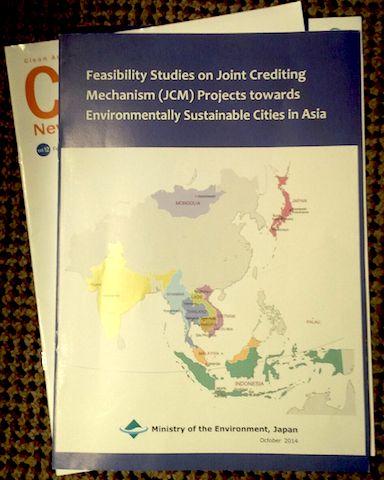Lima, Ekuatorial – Japan offered Joint Crediting Mechanism as clean development mechanism. More simple, faster, however its investment level is still insufficient for companies.
At COP 20, Lima Climate Conference, Japanese International Cooperation Agency or JICA re-introduced Joint Crediting Mechanism (JCM)/Bilateral Offset Credit Mechanism (BOCM), as alternative carbon market to current Clean Development Mechanims (CDM) which had been running since 1997, as a part of Kyoto Protocol.
Unfortunately, CDM is considered unsuccessful by developing countries, as cited in UNEP report on CDM in South East Asia, as too bureaucratic, complicated, and took long time to earn Certified Emissions Reductions (CERs) as legitimization to sell carbon.
As a result, Japan offerred JCM/BOCM which is simpler as it would only involve two parties, — Japanese government and participating countries –. The process to earn CERs would only take one to two years compare to CDM process, under UNFCCC, which involves multi stakeholders and long process. Up to January 2014, JCM has been signed by ten countries and six more countries will join the mechanism for the next three years.
“There are 13 companies from Indonesia listed in JCM and one company had entered the monitoring and evaluation phase to earn CERs,” said Ratu Keni Atika, Monitoring, Evaluation, Dissemination Specialist of JCM Indonesia to Ekuatorial, in Lima, Peru, on Wednesday (3/12).
PT Primatexco Indonesia, a textile company based in Batang, Central Java, signed up on June 2014, was the first company managed to enter MRV [Monitoring, Reporting, and Verification] phase to obtain carbon credits. If Primatexco succeed, they will become the first company to earn carbon credits from JCM.
Atika said that she felt optimistic for more Indonesia companies will receive carbon credits from JCM because the process was much more easy and faster. She added that companies interested for JCM were only need to sign up and proposed low carbon technology that they desired. All emissions from JCM scheme served as offset from Japanese government which will be counted as their emissions reduction efforts.
JICA and Indonesian government will be looking for partners in Japan which suitable with the type and characteristic of low technology carbon proposed by Indonesia. Then, they will set up reference level based on the most efficient technology available in the Indonesian market. “So, reference level does not come from old technology but from the latest technology,” she said.
For instance, if one company in Indonesia wants to adopt JCM to reduce emission from their generator, then its Japanese partner will look for low emission generator sold in Indonesia. Then, emissions from this generator will be used as reference level. Companies in Indonesia and Japan will try to look or develop more low emission generator, its difference will be counted and earn CERs.
Most sophisticated technology used as emission level, she said, was JCM participating countries’ efforts not to become dumping area for expired and high carbon emission technologies.
JCM required all technologies are from Japan, starting from energy saving, transportation efficiency, alternative energy, waste management, CFC eradication, and other technologies.
Nevertheless, Indonesian companies are complaining on high investment for the scheme. Durain Parmanoan of Semen Indonesia, said that they have invested 80 percent of the budget to buy those technologies, meanwhile, their counterpart, JFE Engineering Corp of Yokohama, Japan, only 20 percent.
“We still need to spend money on monitoring and maintenance after the project. Our share should have been lower than that,” said Parmanoan. “Especially, the scheme is related to commitment from developed countries to reduce their emissions.”
If Semen Indonesia succeeded, then emission reduced from boiler, turbines, and generators will be 130,000 tons per year. Currently, one ton cement produce one ton of carbon dioxide. “We are hoping to reach 700 kg per tons of cement,” he said adding that cement industry would be able to reduce up to 650 kg CO2/tons cement by 2020.
Other obstacle from cement industry is contractors tend to use Type 1 cement with high quality but high emissions. Meanwhile, Parmanoan said that there was Portland Composite Cement with good quality but lower emission.
IGG Maha Adi (Lima, Peru)
